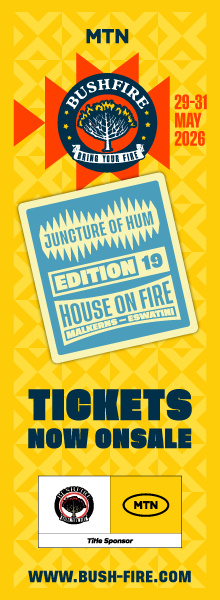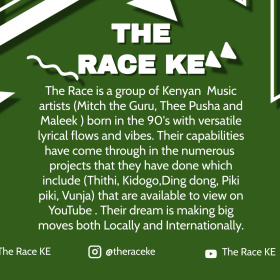Effect of rumba on the Kenyan pop scene
By Amadi Kwaa Atsiaya
Popularized by itinerant Congolese musicians in the sixties and seventies, the rumba sound has come to define the preferred music of the sophisticated urbanite music-lovers, passing down in the family from the treasured collection of singles and LPs that were guarded like the family silver by the grandparents of the current generation. It provided entertainment staple during half-time breaks at live football matches in the seventies to date, and has continued to entertain young and old patrons in entertainment joints all over the region…
 Rumba_musician_Musa_Juma
Rumba_musician_Musa_Juma
In Kenya, rumba as a style of music has become a part of the music tradition in a way that cannot be wished away. Although most of the rumba that has been popular in Kenya is rendered in a language that is not understood by most Kenyans, it has not hindered the universal language of music from communicating with the hearts of the manifold rumba lovers who have demonstrated one of the most enduring loves for music. In addition, native Kenyans have also carved their identity as rumba artistes. Rumba has been described as the folk dance of the Afro-Cubans, which sprang out of the Cuban slums in the mid 19th century. It came to be associated with the rhythm and dancing that was common in the nascent years of modern Congolese music. In some quarters, rumba is generally used to refer to Congolese dance music. The transfer of this type of music between Cuba and Congo is still a phenomenon that has not had any good explanation.
Rumba cannot be discussed without focusing on the history that brought about the rumba phenomenon. One of these historical factors have to do with the history of slavery, when Africans were kidnapped from the continent by slave hunters, who took them away from home, to work for free. These Africans were whisked to far off places like Cuba, where they worked on sugar plantations. With time, these slaves and their descendants developed a musical style, which spread to other parts of the world as the first rumba beat. However, in the Kenyan context, rumba has got a very close relation with the Congo. This is because the rumba beat filtered to Kenya mainly from the then Zaire. During the colonial times, Cuban music found its way to the Congo. The most influential style in the formation of what was to become Rumba Congolaise (Congolese Rumba) had its roots in Cuban son.
There are three major elements that make Cuban son a mirror of Congolese rumba. Whereas son relied mainly on an instrument known as tres for its string effects, Congolese rumba was to find the same feeling in the guitar. Second is the use of hardwood sticks knocked against each other for rhythm and as accompaniment. Third is the general structure of the song, which has two major parts. In Cuban son, there is a lyrical introduction, which breaks into what is known as montuno. This is comparable to the basic structure of rumba, where we have the lyrical section and the instrument-driven seben. In 1947, two Greek brothers –Nico and Alexandros - set up a recording studio in Léopoldville, the then name for Kinshasa under Belgian colonial rule. Known as Ngoma Records, this was to be one of the most important outlets of music not just in the Congo, but also in the whole of the East and Central African region as history was to record later. Ngoma nurtured and exposed the pioneers of Congo’s secular music like Antoine Wendo, Henri Bowane, Leon Bukasa, Oleiveira Feruzi, Adou Elenga and Albert Luampasi. This was the generation that comes just before the generation of Kalle Jeff (as his contemporaries fondly refer to Joseph Kabaselleh of African Jazz) and Franco of TPOK Jazz.
In this period coming after the end of the First World War, there was a music revolution going on in East Africa. The former soldiers who had fought for their colonial masters outside Africa came back with new musical influences and foreign instruments. It is at around this time that East Africa witnessed an increase in the use of instruments such as the trumpet, the accordion and guitar; all of which were acquisitions from their experiences abroad. This can be seen in the centrality of the guitar in Luo benga music, and the accordion in Kikuyu beats such as mwomboko. When Kabaselleh and Franco came onto the scene, their approach to music was fairly cosmopolitan even though the two belonged to different social classes. Franco represented the uneducated musician who was largely self-taught, while Joseph Kabaselleh had attained formal education to an enviable level for an African at the time.
The contrasting social images by the two musicians did not present a dichotomy in the way they regarded the dynamics of music creation. That is how come, the African Jazz Band under the leadership of Joseph Kabaselleh (famous for his song Independence Cha Cha) the high school graduate, initially employed the use of acoustic guitars, acoustic bass (later on the classical bass), pen whistles, trumpets, saxophones and maracas, while their melody and beat imitated what could be heard on the vinyl records that were brought into the Congo from such far off places as Cuba. When TPOK Jazz (as exemplified in their songs Café and Annie) was being formed, the same approach was employed, with a heavy leaning toward acoustic guitars, maracas, clarinet and a distinctly Cuban sound.
With such an active recording environment, with rival bands that were trying hard to outdo each other in music, the Congo became such a vital source of music. Coupled with this music production, Americans established a strong radio station in the Congo (Radio Congolia, later known as Radio Congo Belge) which broadcast to such a wide radius that it reached many parts of the East, Central and West African regions, and thus its music got a wide listenership. Congo also became the musical focal point whereby musicians in East Africa would observe what was happening in Congo and strive to reproduce it.
Records from Congo started finding markets across the border, and when political turmoil engulfed Congo immediately after independence, one of the things that defined the Congolese emigrants around East Africa was the music band. Most of these bands played rumba. Arguably, the most important export to the East African region was more than the rumba beat itself. It was the lesson that a music group could stand its own ground and exclusively depend on music for survival. That is how rumba musical groups emerged all over. From the stature of a Congolese style, the genre acquired local acceptance to the extent that Swahili was used to sing rumba music.
This was not just in terms of Congolese bands (like Orchestre Marquiz who set base in Tanzania alongside Mzee Makassy) choosing to play rumba in Kiswahili, but also local bands and musicians such as Simba Wanyika, Les Wanyika, Fundi Konde, Daudi Kabaka, and Fadhili William choosing to sing rumba in Kiswahili. Furthermore, some local bands chose to adopt rumba to the local Kenyan dialects. That is how Kabasselleh Ochieng of Luna Kidi band and Musa Juma of Limpopo International band established themselves as rumba greats who could play music of Congolese quality, but sang in pure Dholuo, interspersed with Swahili. Still, others chose to lean heavily towards the Congolese style to the extent that their local identities became almost obliterated, save to the keen listener. In this category we have musicians such as Kombo Kombozee from Taita, whose musical identity is rumba with a heavy Congolese leaning, complete with Lingala lyrics.
Along with benga, rumba is one of the most popular beats on the pop scene in Kenya. Even as music tastes have changed with time, with more youthful musicians emerging and other music styles being superimposed onto the Kenyan arena, benga and rumba have not been short of loyal followers. One of the reasons attributed to this loyal following is the nature of rumba songs. Rumba demonstrates a combination of musical beauty in its lyrics, melody, instrumentation on top of narrating touching stories. Most rumba songs (as can be attested from the songs of Musa Juma, Mzee Makassy, Les Wanyika, Simba Wanyika) tell a story about love, broken hearts, sad encounters in life, aspiration to a brighter future or celebration of good times. The lyrics are woven together in such a poetic manner and delivered in a melody and musical accompaniment that is spell-binding. It is the kind of music that seems to improve in appeal with age.
Taking stock of the number of people who have been collecting music in Kenya, the genre that is most popular with collectors is rumba. Asked why they focus mainly on rumba, many collectors liken rumba to wine. They say that a rumba song that was recorded in the 1960s is sweeter today than it was during the days of its production. Tony Najori, who collects music in Nairobi, especially music produced on vinyl records, cites the example of the music of John Ondolo, a rumba musician of the 1960s and 1970s who used the pen whistle in most of his songs, just like the kwela musicians from Southern Africa.
Tony Najori throws a challenge to anyone who can find a band that still uses the pen whistle in its songs today. He contends that some of these instruments (like the pen whistle) are no longer in existence, so their sound remains exceptional, and can hardly be reproduced by anyone, thus making this kind of music eternal. Tony further equates modern music to highly perishable goods. It does not last long on the shelves. According to him, the songs that ruled the airwaves in the last decade have either been forgotten, or can hardly excite the revelers who found them appealing then. On the contrary the rumba songs that were great hits in the 1960s will still appeal to those who had the privilege to listen to them when they were hits.
Taking stock of the entertainment spots in Kenya, especially those patronized by people of the middle age and above, it can be noted that the resident bands will always reserve a place for rumba music, even if the rest of the repertoire is contemporary fast-paced music. Rumba is always guaranteed patronage. Often it is the base upon which the rest of the performance is built. Even where it morphs into other genres like Soukous and Techno, the root music is always rumba. To many people in the larger East and Central African region, it is a mark of identity; the music of the people.
SOURCES: Rumba in the City of Peace: Migration and the Cultural Commodity of Congolese Music in Dar es Salaam, 1968-1985 Author(s): Alex Perullo Source: Ethnomusicology, Vol. 52, No. 2 (Spring/Summer, 2008), pp. 296-323 Published by: University of Illinois Press on behalf of Society for Ethnomusicology Stable URL: http://www.jstor.org/stable/20174590 . Accessed: 29/03/2014 16:40 The Record Industry: The Growth of a Mass Medium Author(s): Pekka Gronow Source: Popular Music, Vol. 3, Producers and Markets (1983), pp. 53-75 Published by: Cambridge University Press Stable URL: http://www.jstor.org/stable/853094. Accessed: 04/10/2013 13:18 MwambaNgoma: A documentary film on the development of Dance Music in Tanzania https://www.youtube.com/watch?v=qQHKg9-JM5M Accessed: 04/10/2013 13:18 Faces of Africa-Franco King Of Rumba: A Documentary film about Franco and the O.K Jazz http://www.youtube.com/watch?v=QkdFRYgl7cs Accessed: 14/11/2013 14:00 Personal Interview with Tony Najori, rumba music collector, Nairobi August 2010




















Comments
Log in or register to post comments